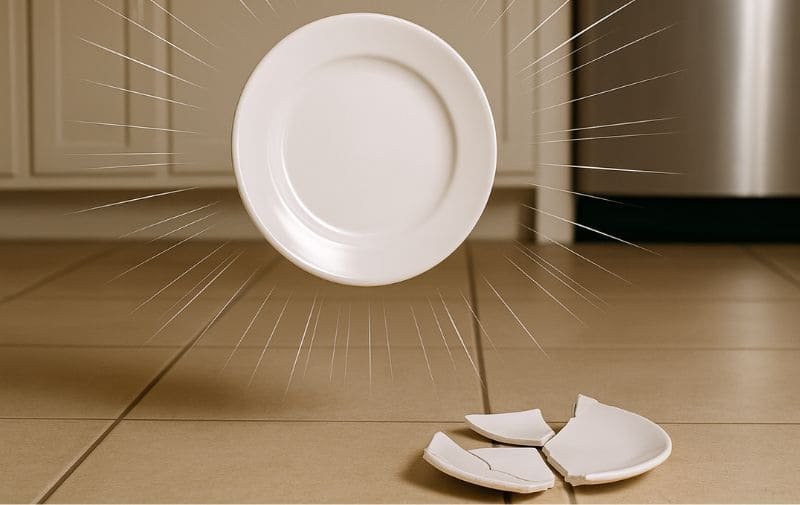You’re tired of shattered ceramic plates and flimsy disposables. You need dinnerware that can survive drops from the kids, busy restaurant service, and countless cycles through the dishwasher. Melamine promises durability, but how tough is it really?
High-quality A5 melamine plates are exceptionally durable. They are virtually shatterproof when dropped from table height and are designed to last for years in both homes and commercial restaurants. While they can be scratched by sharp steak knives, they are highly resistant to chipping, breaking, and staining.
That’s the promise, but not all melamine is created equal. The difference between a plate that lasts a decade and one that looks old in a year comes down to hidden factors: the grade of the material, the design of the plate itself, and how you care for it. Let’s break down what true melamine durability means, from the drop test to the “slow killers” that determine its real-world lifespan.
Last Updated: Sep 15th. 2025 | Estimated Reading Time: 23 Minutes
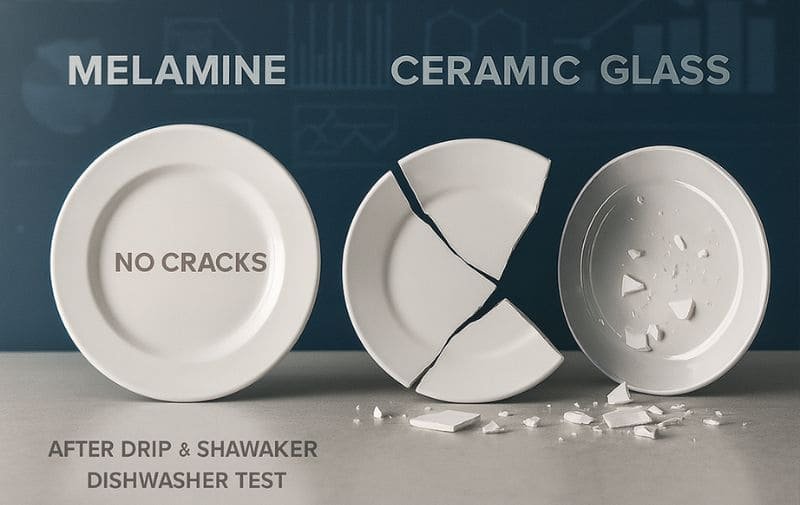
How Does Melamine Stack Up Against a Drop from the Table?
In the industry, the baseline quality control check is the 70cm drop test. This simulates a plate falling from a standard dining table onto a hard surface. To be sold, a plate must survive this impact without chipping or cracking.
The 70cm Rule: A Passing Grade, Not an ‘A+’
This is the classic test of strength. What happens when a plate slips and falls onto a hard floor? With traditional dinnerware, the result is a sharp crack and a dangerous mess of broken shards. Melamine is different.
Melamine dinnerware will not shatter when dropped. Its thermoset plastic construction is designed to absorb impact, making it ideal for high-use environments like restaurants, outdoor patios, poolside dining, and homes with children.
Industry Insight: The 70cm test is a binary “pass/fail” benchmark; it’s the absolute minimum standard. A cheap plate is engineered to pass this one test. A premium, commercial-grade plate is engineered for the real world. It’s designed to survive repeated drops from over 1 to 1.2 meters, onto surfaces like concrete.
Break-Resistance at a Glance
Material Impact from Table Height (70cm) Chip Resistance Ideal Use Case High-Quality Melamine Bounces, will not shatter or break. High Restaurants, Outdoors, Families Porcelain / China Will likely shatter into large pieces. Moderate Formal Dining, Careful Use Corelle (Vitrified Glass) Often survives, but can shatter explosively. High Everyday Home Use Stoneware Will break and chip easily. Low Rustic, Casual Dining Standard Glass Will shatter into many dangerous shards. Very Low Careful Adult Use Only
But Are All Melamine Plates Created Equal? The Secret Code to Durability
This is the most critical factor in melamine durability, and it’s something 90% of consumers are unaware of. The true strength and safety of your plate are determined by its manufacturing grade.
For maximum durability, stain resistance, and heat tolerance, you must choose dinnerware made from 100% A5,A8 grade melamine. Lower grades like A1 are cheaper, more brittle, and not suitable for long-term food service.
If you see a price for a melamine set that seems too good to be true, the manufacturer is almost certainly using a lower-grade material. It might survive a drop when new, but it will fail you in every other aspect of durability within months.
A5,A8 vs. A1: What You’re Really Paying For
| Feature | A5,A8 Grade Melamine | A1 Grade Melamine |
|---|---|---|
| Composition | 100% Pure Melamine-Formaldehyde Resin | Blend of Melamine and cheaper Urea-Formaldehyde Resin |
| Break Resistance | Highest. Very strong and resilient. | Lower. More brittle and prone to cracking over time. |
| Heat Tolerance | Up to 120°C (248°F). Safe for hot food and commercial dishwashers. | Only up to 80°C (176°F). Can warp, crack, or release odors with hot foods. |
| Stain Resistance | Excellent. Dense, non-porous glaze resists stains from coffee, tea, and tomato sauce. | Poor. More porous surface absorbs stains easily. |
| Food Safety | Certified Food-Grade. Stable and safe for serving all types of food. | Not Recommended for Food. Can break down and leach chemicals. |
| Cost | Higher Initial Investment | Lower Price Point |
Insider Tip: Always ask your supplier or check the product specifications for “A5 Grade” or “100% Melamine.” Reputable brands will state this clearly. If they don’t, assume it’s a lower-grade product.t it will fail you in every aspect of durability within months. For dinnerware, always demand 100% A5 grade.
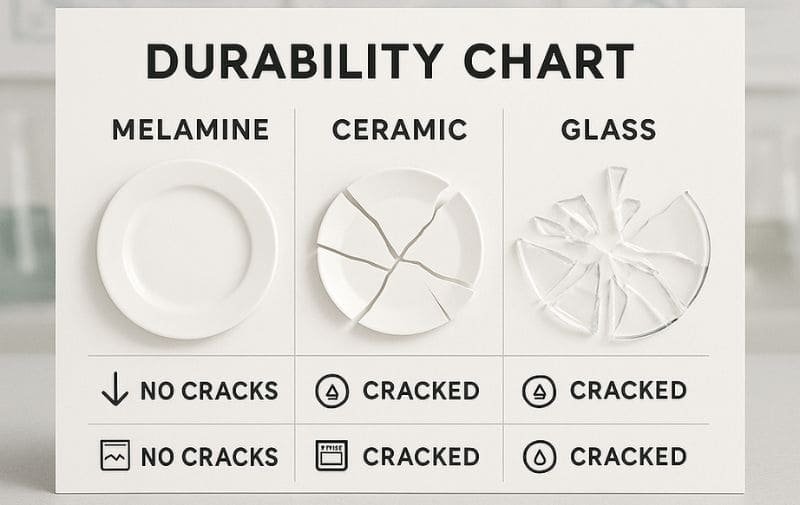
What About Scratches, Stains, and Heat? The “Slow Killers” of Durability
A plate can “die” and need to be replaced without ever breaking. True durability is about resisting the slow degradation of everyday use. These are the three “slow killers” you need to watch out for.
A durable plate must resist scratches from cutlery, stains from food, and the thermal shock of washing. This is where high-quality A5 melamine’s dense, protective glaze proves its worth.
Let’s look at how melamine holds up to these daily challenges.
1. Scratch Resistance
- Forks and Spoons: Everyday use with forks and spoons is perfectly fine and will not scratch the surface of a quality melamine plate.
- The Culprit: Steak Knives: A sharp or serrated knife, especially a steak knife, is melamine’s primary enemy. The concentrated pressure is designed to cut through tough meat, and it will also cut through the plate’s glaze, leaving a permanent scratch. The Rule: If the meal requires a steak knife, use a ceramic plate.
2. Heat & Chemical Resistance
- Hot Foods: Melamine is an excellent insulator and is designed to handle piping hot foods and liquids without any problem.
- The Microwave: NEVER put melamine in the microwave. The resin is not designed for this type of radiation. It will absorb the microwave energy, potentially scorching, cracking, or warping the plate and releasing harmful chemicals.
- Dishwashers: A5 melamine is built to withstand the high temperatures (up to 248°F) of commercial dishwashers. However, to preserve the glossy finish, avoid harsh, abrasive detergents (like industrial powders) and never use steel wool or scouring pads.
3. Stain Resistance
A high-quality A5 melamine plate has a very hard, non-porous glaze that acts like armor. This surface prevents acidic or colorful foods like tomato sauce, curry, or coffee from penetrating and causing a permanent stain. Lower-grade A1/A3 melamine is more porous and will absorb these colors over time, making it look old and dirty.
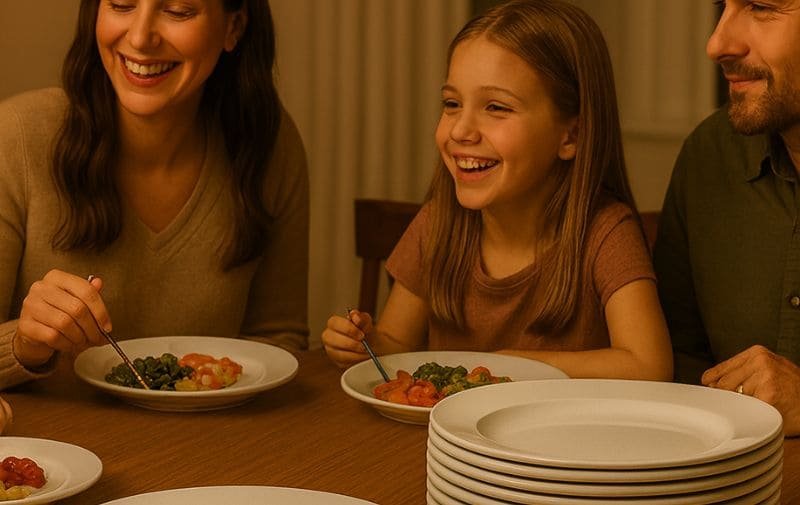
The Architectures of Strength: The Importance of Design
The physical design of a plate is a critical, often overlooked, component of its durability. Two plates made from the exact same A5 melamine can have vastly different lifespans due to their construction.
- Rim Design: A thick, rounded, and reinforced rim is far more resistant to chipping during stacking and handling than a thin, flat rim.
- Foot Ring: The small rim on the bottom of a plate isn’t just for show; it adds significant structural rigidity and prevents the plate from cracking across the middle under pressure.
- Uniform Thickness: High-quality plates have a perfectly consistent thickness from the center to the rim. Cheaper plates often have thin spots which create weak points just waiting to fail.
A Note on Bamboo Fiber Composites
Modern eco-friendly plates often blend bamboo fiber (30-40%) with melamine resin. This changes the durability profile:
- The Good: The embedded fibers add flexibility, making the plate less brittle and even more shatter-resistant in some cases.
- The Trade-off: The surface is often not as hard and glossy as pure A5 melamine. This can make it slightly more susceptible to deep scratches and staining if the final glaze quality isn’t top-tier.
The Home & Restaurant Reality: How Long Do Plates Actually Last?
So, how long can you actually expect your plates to last? This is where the difference between home use and the brutal reality of a commercial kitchen becomes clear.
With proper care, a set of high-quality A5 melamine plates can last 3-7 years in a home. In a busy restaurant, the expected lifespan is 2-5 years, with an annual replacement rate of just 10-20%, compared to 50-100% for ceramic dinnerware.
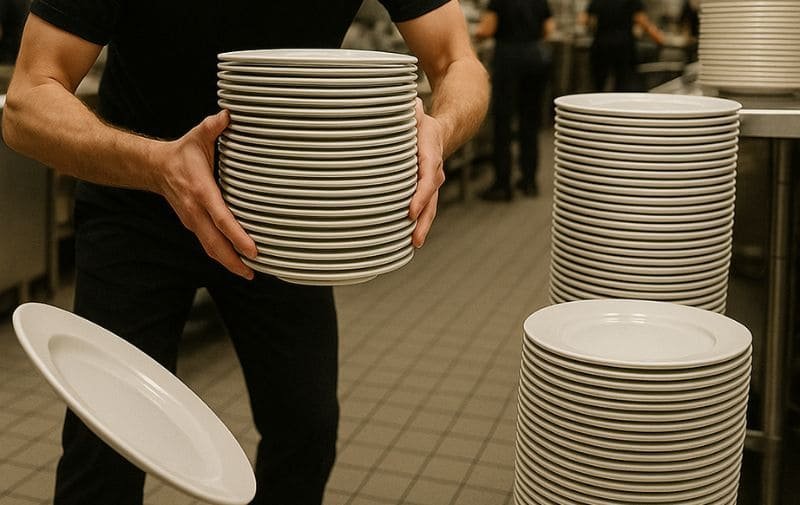
In the restaurant world, we measure durability by the “annual replacement rate.” A busy restaurant might have to replace its entire stock of ceramic plates over one to two years due to constant chipping and breaking. With A5 melamine, they only need to replace a small fraction of their inventory each year. This is melamine’s single biggest financial advantage. The initial cost may be slightly higher than cheap ceramic, but the total cost of ownership over time is dramatically lower.
You’ll know it’s time to replace a melamine plate when you see:
- Any visible chips or cracks, which can harbor bacteria.
- Deep, numerous scratches from improper knife use.
- A dull, faded finish from years of washing and use.
- Persistent stains that can no longer be removed.
| Dinnerware Type | Average Annual Replacement Rate (Busy Restaurant) | Key Reason for Replacement |
|---|---|---|
| Standard Ceramic / China | 50% – 100% | Breakage and major chipping. |
| Low-Quality (A1/A3) Melamine | 30% – 50% | Staining, warping, cracking, loss of glaze. |
| High-Quality (A5) Melamine | 10% – 15% | Minor chips from extreme abuse, deep scratches, or loss after years of service. |
Conclusion
High-quality A5 melamine is one of the most durable dinnerware materials on the market. It excels in break and chip resistance, but its true longevity depends on proper care. Avoid steak knives and microwaves, and your plates will serve you reliably for years, providing unmatched long-term value.
Frequently Asked Questions (F.A.Q.)
1. Can you use steak knives on melamine plates?
It is not recommended. While melamine is scratch-resistant against regular cutlery, sharp or serrated steak knives can cut into the surface. Over time, these deep scratches can trap food particles and bacteria. For this reason, many restaurants use wooden platters or ceramic plates for serving steak.
2. Why do my old melamine plates look faded or dull?
The loss of the shiny, protective glaze is usually caused by two things: years of washing with harsh, abrasive dishwasher detergents, or the use of scouring pads or abrasive cleaners like Comet, which physically wear down the surface.
3. Will melamine warp in the dishwasher?
High-quality A5 grade melamine will not warp, even in high-temperature commercial dishwashers up to 120°C (248°F). Lower quality A1 or A3 grade melamine, however, has poor heat resistance and can easily warp or become misshapen.
4. Is thicker melamine always more durable?
Not necessarily. While thickness helps, uniform construction and the grade of the material (A5) are more important. A well-designed A5 plate with a reinforced rim and foot can be more durable than a thicker but poorly designed plate made from a brittle, lower-grade material.
5. Does melamine get weaker or more brittle over time?
With hundreds of cycles of heating and cooling in a dishwasher, the material can lose some of its initial resilience over many years. However, its primary mode of failure will still be surface wear (scratches and dulling) long before it becomes brittle enough to break from a normal drop.
6. Is melamine safe if it gets chipped?
A small, smooth chip on the rim is generally not a safety hazard. However, it’s best to retire the plate. The chip breaks the protective outer glaze, creating a spot where bacteria could potentially collect and making the plate more susceptible to further damage or staining.
Recommended
Are Melamine Plates Recyclable? The Definitive Sustainability Guide
NSF International – Food Equipment Standards (Authoritative source on food safety standards)

